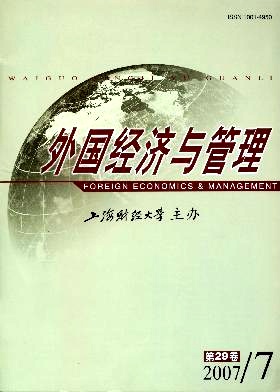零时间组织的团队集群结构探析
外国经济与管理 2007 年 第 29 卷第 07 期, 页码:23 - 29
摘要
参考文献
摘要
从基于时间竞争到零时间组织的提出,是一个从宏观战略描述到微观运作探索的过程,对零时间组织的现实需要要求我们进一步预测和求证零时间组织的具体结构。本文分析了跨越组织内外边界的多职能团队(多职能团队由于拥有健全的职能体系,有效地克服隐性知识的转移和共享困难,从而能成为零时间组织的基本构成单元),并按照合拢管理思想和知识与决策权匹配理论,提出了实现零时间组织的团队集群结构和六种集群团队的组合形式。
[1]Stalk,G Jr,and Hout,T M.Competing against time:How time-based competition is reshaping global markets[M].New York:The Free Press,1990.
[2]Chandler,A D.The visible hand:The managerial revolution in American business[M].Cambridge,MA:Belknap Press,1977.
[3]Stalk,G Jr.Time-the next source of competitive advantage[J].Harvard Business Review,1988,66(Jul./Aug.):41-51.
[4]Ashok,K,and Jaideep,M.A methodology for assessing time-based competitive advantage of manufacturing firms[J].InternationalJournal of Operations&Production Management,1995,15(2):36-53.
[5]Hum,S H,and Sim,H H.Time-based competition:Literature review and implications for modeling[J].International Journal ofOperations&Production Management,1996,16(1):75-90.
[6]Toni,D A,and Meneghetti,A.Traditional and innovative path towards time-based competition[J].International Journal of Produc-tion Economics,2000,66(3):255-268.
[7]Stalk,G Jr,and Webber A M.Japan’s dark side of time[J].Harvard Business Review,1993,71(4):93-102.
[8]Braun,V,and Friedrich,C.The acceleration trap in the real world[J].Sloan Management Review,1991,32(4):43-52.
[9]Meyer,C.The second generation of speed[J].Harvard Business Review,2001,179(4):24-26.
[10]周伯生,樊东平.零时间:21世纪企业的概念架构[J].中国机械工程,2000,11(1/2):89-92.
[11]Stalk,G Jr,and Istvan,R.New competitive age[J].Executive Excellence,1989,6(10):5-10.
[12]Daniels,N C,and Essaides,G.Time-based competition[M].London:Economic Intelligence Unit,1993:98-104.
[13]Roberts,D R,and Rollins,T.Employee research is a powerful tool in leading the time-based organization[J].Employee RelationsToday,1995,22(4):11-17.
[14]雷蒙德.叶,克瑞.皮尔逊,乔治.科兹梅特斯基著;唐德琴等译.零时:即时响应客户需求的创新战略[M].北京:电子工业出版社,2002.
[15]弗兰克.莱坎.德普雷,勒内.蒂森著;李家强译.零度管理[M].北京:中信出版社,2005:23.
[2]Chandler,A D.The visible hand:The managerial revolution in American business[M].Cambridge,MA:Belknap Press,1977.
[3]Stalk,G Jr.Time-the next source of competitive advantage[J].Harvard Business Review,1988,66(Jul./Aug.):41-51.
[4]Ashok,K,and Jaideep,M.A methodology for assessing time-based competitive advantage of manufacturing firms[J].InternationalJournal of Operations&Production Management,1995,15(2):36-53.
[5]Hum,S H,and Sim,H H.Time-based competition:Literature review and implications for modeling[J].International Journal ofOperations&Production Management,1996,16(1):75-90.
[6]Toni,D A,and Meneghetti,A.Traditional and innovative path towards time-based competition[J].International Journal of Produc-tion Economics,2000,66(3):255-268.
[7]Stalk,G Jr,and Webber A M.Japan’s dark side of time[J].Harvard Business Review,1993,71(4):93-102.
[8]Braun,V,and Friedrich,C.The acceleration trap in the real world[J].Sloan Management Review,1991,32(4):43-52.
[9]Meyer,C.The second generation of speed[J].Harvard Business Review,2001,179(4):24-26.
[10]周伯生,樊东平.零时间:21世纪企业的概念架构[J].中国机械工程,2000,11(1/2):89-92.
[11]Stalk,G Jr,and Istvan,R.New competitive age[J].Executive Excellence,1989,6(10):5-10.
[12]Daniels,N C,and Essaides,G.Time-based competition[M].London:Economic Intelligence Unit,1993:98-104.
[13]Roberts,D R,and Rollins,T.Employee research is a powerful tool in leading the time-based organization[J].Employee RelationsToday,1995,22(4):11-17.
[14]雷蒙德.叶,克瑞.皮尔逊,乔治.科兹梅特斯基著;唐德琴等译.零时:即时响应客户需求的创新战略[M].北京:电子工业出版社,2002.
[15]弗兰克.莱坎.德普雷,勒内.蒂森著;李家强译.零度管理[M].北京:中信出版社,2005:23.
引用本文
陈建安, 胡蓓. 零时间组织的团队集群结构探析[J]. 外国经济与管理, 2007, 29(7): 23–29.
导出参考文献,格式为:
上一篇:战略过程研究述评与展望
下一篇:国外组织责任行为研究模式评介





 7112
7112  274
274

